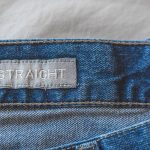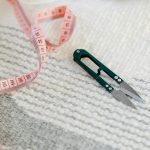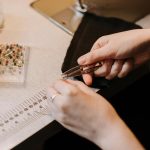Looking for the perfect dress cut that flatters your figure? Wondering if bias or straight cut is the way to go?
This guide will help you navigate the ins and outs of choosing the best dress cut for your next special occasion. Whether you're aiming for a sleek and structured look or a more fluid and draped style, understanding the unique characteristics of bias and straight cuts will empower you to make an informed decision.
No need to stress about which cut will suit you best – by considering factors such as body type and styling tips, you'll be equipped to confidently choose the perfect dress cut for any event.
Key Takeaways
- Bias cuts create a fluid and figure-hugging silhouette, while straight cuts offer a more structured and tailored look.
- Bias-cut garments drape elegantly and accentuate the body's curves, while straight-cut patterns use less fabric and provide a structured appearance.
- Bias cuts are flattering for a variety of body shapes and sizes, while straight cuts add definition and curves for athletic or rectangular body shapes.
- When choosing a dress cut, consider the fabric choices, desired movement and aesthetic, as well as the body shape and proportions to determine the most complementary style.
The Definition of Bias and Straight Cuts
You might be wondering what exactly bias and straight cuts refer to in the world of dressmaking.
Well, bias cut refers to fabric that's cut on a diagonal angle, typically at 45 degrees to the straight grain of the fabric. This technique allows the fabric to drape and cling to the body, creating a fluid and figure-hugging silhouette.
On the other hand, straight cuts are made parallel to the fabric's straight grain, resulting in a more structured and tailored look.
When it comes to draping techniques, bias-cut garments have a unique ability to drape elegantly and accentuate the body's curves, whereas straight-cut garments tend to have a more rigid and angular drape.
In terms of sewing patterns, bias-cut patterns require more fabric due to the diagonal nature of the cut, while straight-cut patterns use less fabric and often produce less waste.
Fashion trends often dictate whether bias or straight cuts are in vogue. While bias-cut dresses are often associated with a more fluid and romantic aesthetic, straight-cut dresses are favored for their clean lines and tailored appearance.
Understanding the distinctions between bias and straight cuts allows dressmakers to choose the most suitable technique for their desired garment style.
The Unique Characteristics of Bias Cuts
When considering the unique characteristics of bias cuts, it's important to recognize their unparalleled ability to create a graceful and body-contouring silhouette. The advantages of bias cuts include:
- Enhanced Draping Techniques: Bias cuts allow for a more fluid and natural drape on the body compared to straight cuts.
The fabric falls and flows in a way that complements the body's curves, creating an elegant and flattering look.
- Fluid Fabric Movement: The bias cut allows the fabric to move with the body, providing a sense of ease and comfort.
This creates a dynamic and visually appealing effect as the garment moves with the wearer.
- Body Type Considerations: Bias cuts are known for their ability to flatter a variety of body shapes and sizes.
The natural stretch and drape of bias-cut fabric allow the dress to gently hug the body, offering a tailored fit that emphasizes the figure.
Understanding these unique characteristics of bias cuts can help you appreciate the artistry and craftsmanship involved in creating garments that not only look beautiful but also feel incredibly comfortable and flattering.
The Unique Characteristics of Straight Cuts
Exploring the unique characteristics of straight cuts reveals their distinct ability to provide a structured and tailored appearance, offering a sleek and polished aesthetic that differs from the fluidity of bias cuts. Fabric characteristics play a significant role in the success of straight cuts.
Fabrics with more body and structure, such as wool crepe or cotton twill, are often the preferred choice for straight cuts due to their ability to hold the shape and create clean lines. Unlike bias cuts that drape and flow with the body, straight cuts rely on the fabric's ability to maintain a defined silhouette.
Sewing techniques for straight cuts focus on precision and clean lines. Seam finishes and hems are meticulously executed to ensure a polished and professional look. The construction of straight cuts demands attention to detail, with an emphasis on sharp corners, crisp edges, and minimalistic finishes. Unlike bias cuts, which often require special techniques to accommodate the fabric's stretch and drape, straight cuts rely on precise stitching and structural reinforcement to achieve their tailored appearance.
In mastering the unique characteristics of straight cuts, it's essential to understand how fabric characteristics and meticulous sewing techniques contribute to the creation of a structured and polished aesthetic.
Factors to Consider When Choosing a Dress Cut
Consider the fabric's characteristics and your desired aesthetic when choosing between bias or straight cuts for your dress. Fit and body shape play a crucial role in determining the most flattering dress cut for you. Additionally, fabric choices greatly impact the movement and drape of the dress, influencing the overall look and feel.
- Fit and body shape: Your body shape and the fit you desire are essential factors to consider when deciding between a bias or straight cut. A bias cut is known for its ability to hug the body's natural curves, making it ideal for those desiring a form-fitting silhouette. On the other hand, a straight cut may offer a more structured and tailored look, suitable for various body shapes.
- Fabric choices: The type of fabric you choose can significantly affect the movement of the dress. Fluid and drapey fabrics, such as silk or satin, are well-suited for bias cuts, as they enhance the natural flow and drape of the garment. In contrast, stiffer fabrics like cotton or wool may be better suited for straight cuts, providing a more structured and defined silhouette.
- Movement: Consider how you want the dress to move. A bias cut dress will sway and drape with your body's movement, creating an elegant and fluid appearance. On the other hand, a straight cut dress may offer a more controlled and defined movement, suitable for certain aesthetics or occasions.
How Bias and Straight Cuts Flatter Different Body Types
To determine which dress cut flatters different body types, assess your individual proportions and silhouette to find the most complementary style.
Bias-cut dresses are known for their ability to drape and hug the body, making them ideal for accentuating curves and creating a sleek, elongated silhouette. The diagonal grain of the fabric in bias-cut dresses allows them to stretch and mold to the body, making them particularly flattering for hourglass and pear-shaped figures.
On the other hand, straight-cut dresses offer a more structured and tailored look, making them suitable for a wider range of body types. This cut is especially flattering for those with an athletic or rectangular body shape, as it can create the illusion of curves and add definition to the waistline.
When considering bias vs straight cuts, it's important to take into account your body shape and proportions to determine which style will best enhance your natural silhouette. Both cuts offer various styling options, allowing you to find the perfect dress cut that complements your unique body shape.
Styling Tips for Bias and Straight Cut Dresses
Try experimenting with different accessories to enhance the overall look when styling bias or straight cut dresses. Accessories can make a significant difference in how both cuts are perceived, so it's important to choose wisely. Here are some styling techniques to consider:
- Fabric types: When styling bias cut dresses, opt for delicate and lightweight accessories to complement the fluidity of the fabric. For straight cut dresses, structured accessories such as belts or statement jewelry can add definition to the silhouette.
- Flattering silhouettes: Use accessories to accentuate the natural flow of bias cut dresses by incorporating belts to cinch the waist or scarves to add dimension. For straight cut dresses, consider layering with a tailored blazer or adding a belt to emphasize the waistline.
- Color choices: Accessorize bias cut dresses with complementary colors to create a harmonious look while using contrasting hues to add visual interest. With straight cut dresses, experiment with monochromatic accessories for a sleek and sophisticated ensemble or add a pop of color for a more vibrant appearance.
Final Tips for Choosing the Best Dress Cut
When choosing the best dress cut, consider how it fits your body shape and how the fabric drapes and moves.
These two points are crucial in determining which cut will flatter your figure and provide the desired level of comfort and movement.
Fit and Body Shape
The key to finding the best dress cut for your body shape is understanding how different styles flatter your figure. When considering fit and proportion, look for a dress cut that accentuates your best features while downplaying areas you're less confident about.
Additionally, consider the style and versatility of the dress cut. Choose a style that complements your body shape and can be worn for various occasions. Versatility allows you to get more wear out of the dress, making it a practical investment for your wardrobe.
Lastly, take into account the fabric and pattern of the dress cut. Certain fabrics and patterns can create the illusion of a different body shape, helping you achieve the desired look.
Fabric Drape and Movement
Consider how the fabric drapes and moves on your body to determine the best dress cut for your figure. The fabric movement is crucial in achieving a silhouette that flatters your body shape.
For instance, a bias-cut dress skims the body, enhancing natural curves and creating beautiful movement as you walk. This cut is perfect for those looking for a dress that gently hugs the body and accentuates the figure.
On the other hand, a straight-cut dress with a stiffer fabric may offer a more structured and tailored look, ideal for those who prefer a more defined silhouette.
When choosing a dress cut, pay attention to how the fabric drapes and moves on your body to ensure that it complements your shape and provides the desired level of comfort and style.
Frequently Asked Questions
Can Bias and Straight Cuts Be Combined in One Dress?
Yes, bias and straight cuts can be combined in one dress, offering design flexibility. Combining cuts allows for unique and dynamic silhouettes, adding interest and creativity to the garment's overall design.
Are Bias and Straight Cuts More Suitable for Certain Types of Fabric?
When considering fabric compatibility, bias and straight cuts have different effects. Bias cuts work well with stretchy fabrics, creating a fluid and draped look. Straight cuts suit more structured fabrics, providing clean lines and a tailored appearance.
How Do Bias and Straight Cuts Affect the Drape and Movement of the Dress?
Bias cut dresses have a fluid fabric drape due to the diagonal grain, allowing for natural movement. Straight cuts offer a more structured look, with less drape and movement. Consider your dress construction and desired movement properties when choosing between these cuts.
Are There Any Historical or Cultural Associations With Bias and Straight Cuts?
Historical associations with dress cuts reflect the evolution of fashion and societal norms, while cultural influences often dictate preferred styles and shapes. Understanding the origins and significance of bias and straight cuts can enhance your mastery of dressmaking.
Can Bias and Straight Cuts Be Altered to Better Fit Individual Body Shapes?
When tailoring options are considered, both bias and straight cuts can be altered to better fit individual body shapes. Fit customization allows for body shape adaptation, ensuring that the dress complements your unique figure.
- How to Soften Stiff Calico Fabric: 5 Simple and Effective Methods - June 19, 2025
- How Calico Fabric Is Made: From Cotton Boll to Printed Textile - June 19, 2025
- Where to Buy Calico Fabric: The Best Stores Online and In-Person - June 19, 2025







